2006 FORD F SERIES MOTORHOME AND COMMERCIAL CHASSIS battery
[x] Cancel search: batteryPage 92 of 128
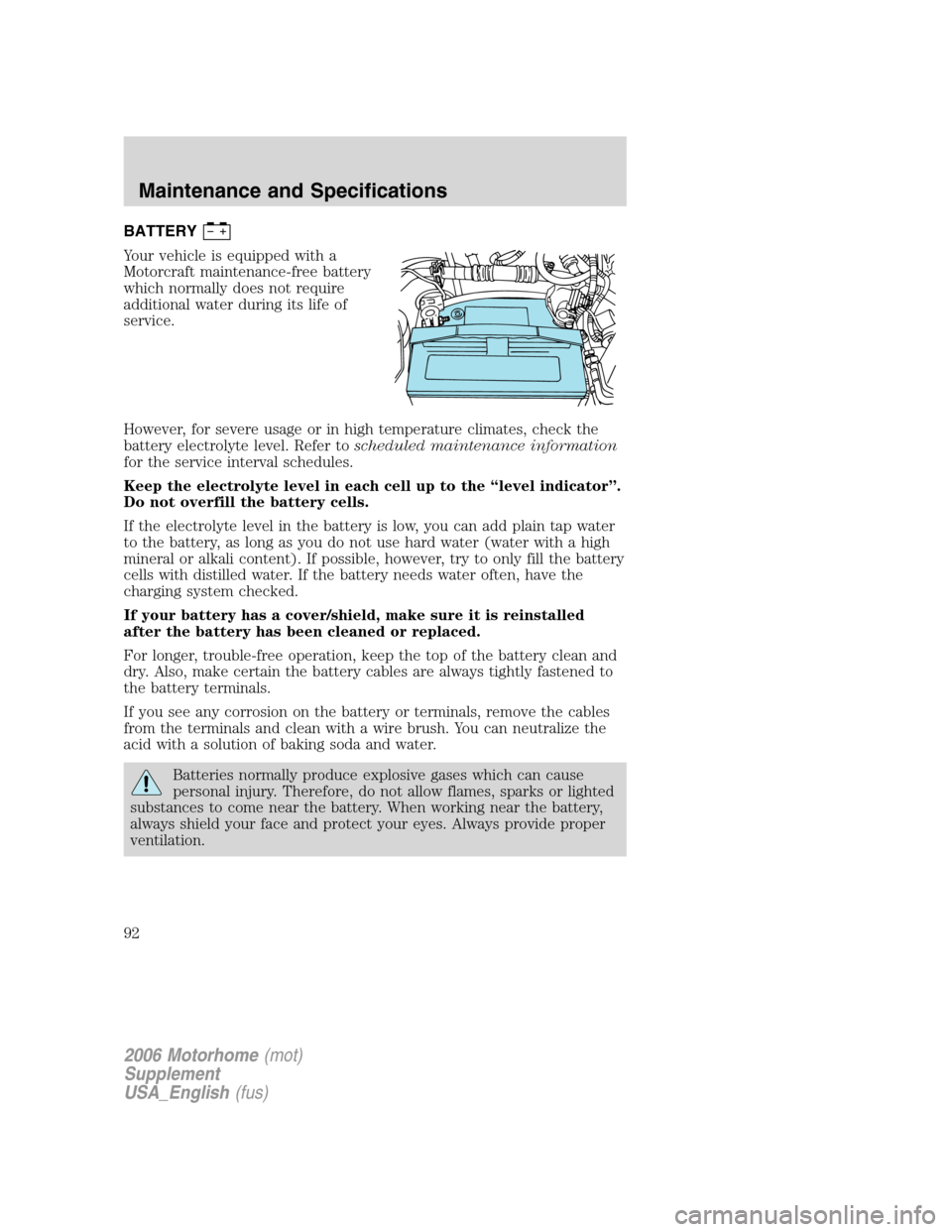
BATTERY
Your vehicle is equipped with a
Motorcraft maintenance-free battery
which normally does not require
additional water during its life of
service.
However, for severe usage or in high temperature climates, check the
battery electrolyte level. Refer toscheduled maintenance information
for the service interval schedules.
Keep the electrolyte level in each cell up to the “level indicator”.
Do not overfill the battery cells.
If the electrolyte level in the battery is low, you can add plain tap water
to the battery, as long as you do not use hard water (water with a high
mineral or alkali content). If possible, however, try to only fill the battery
cells with distilled water. If the battery needs water often, have the
charging system checked.
If your battery has a cover/shield, make sure it is reinstalled
after the battery has been cleaned or replaced.
For longer, trouble-free operation, keep the top of the battery clean and
dry. Also, make certain the battery cables are always tightly fastened to
the battery terminals.
If you see any corrosion on the battery or terminals, remove the cables
from the terminals and clean with a wire brush. You can neutralize the
acid with a solution of baking soda and water.
Batteries normally produce explosive gases which can cause
personal injury. Therefore, do not allow flames, sparks or lighted
substances to come near the battery. When working near the battery,
always shield your face and protect your eyes. Always provide proper
ventilation.
2006 Motorhome(mot)
Supplement
USA_English(fus)
Maintenance and Specifications
92
Page 93 of 128
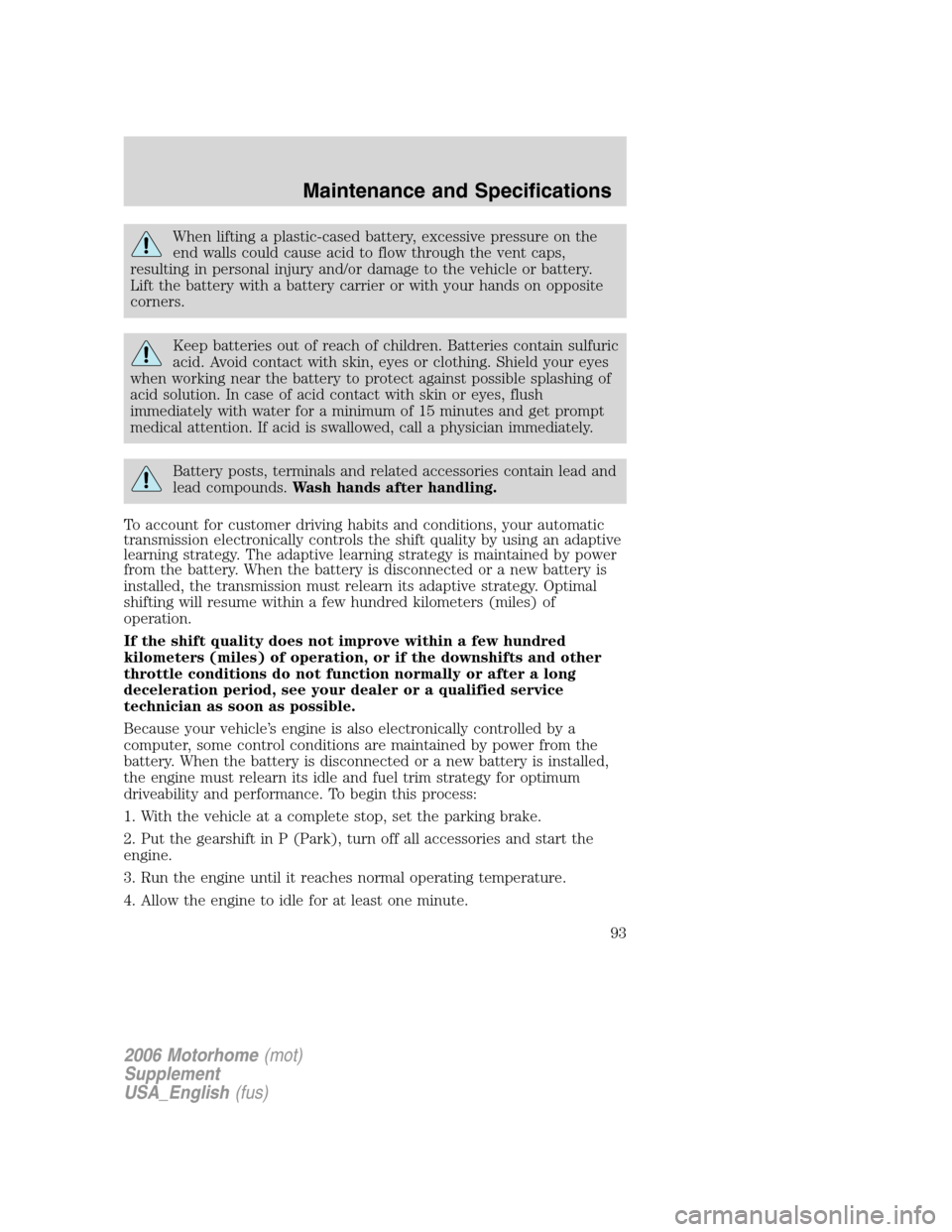
When lifting a plastic-cased battery, excessive pressure on the
end walls could cause acid to flow through the vent caps,
resulting in personal injury and/or damage to the vehicle or battery.
Lift the battery with a battery carrier or with your hands on opposite
corners.
Keep batteries out of reach of children. Batteries contain sulfuric
acid. Avoid contact with skin, eyes or clothing. Shield your eyes
when working near the battery to protect against possible splashing of
acid solution. In case of acid contact with skin or eyes, flush
immediately with water for a minimum of 15 minutes and get prompt
medical attention. If acid is swallowed, call a physician immediately.
Battery posts, terminals and related accessories contain lead and
lead compounds.Wash hands after handling.
To account for customer driving habits and conditions, your automatic
transmission electronically controls the shift quality by using an adaptive
learning strategy. The adaptive learning strategy is maintained by power
from the battery. When the battery is disconnected or a new battery is
installed, the transmission must relearn its adaptive strategy. Optimal
shifting will resume within a few hundred kilometers (miles) of
operation.
If the shift quality does not improve within a few hundred
kilometers (miles) of operation, or if the downshifts and other
throttle conditions do not function normally or after a long
deceleration period, see your dealer or a qualified service
technician as soon as possible.
Because your vehicle’s engine is also electronically controlled by a
computer, some control conditions are maintained by power from the
battery. When the battery is disconnected or a new battery is installed,
the engine must relearn its idle and fuel trim strategy for optimum
driveability and performance. To begin this process:
1. With the vehicle at a complete stop, set the parking brake.
2. Put the gearshift in P (Park), turn off all accessories and start the
engine.
3. Run the engine until it reaches normal operating temperature.
4. Allow the engine to idle for at least one minute.
2006 Motorhome(mot)
Supplement
USA_English(fus)
Maintenance and Specifications
93
Page 94 of 128
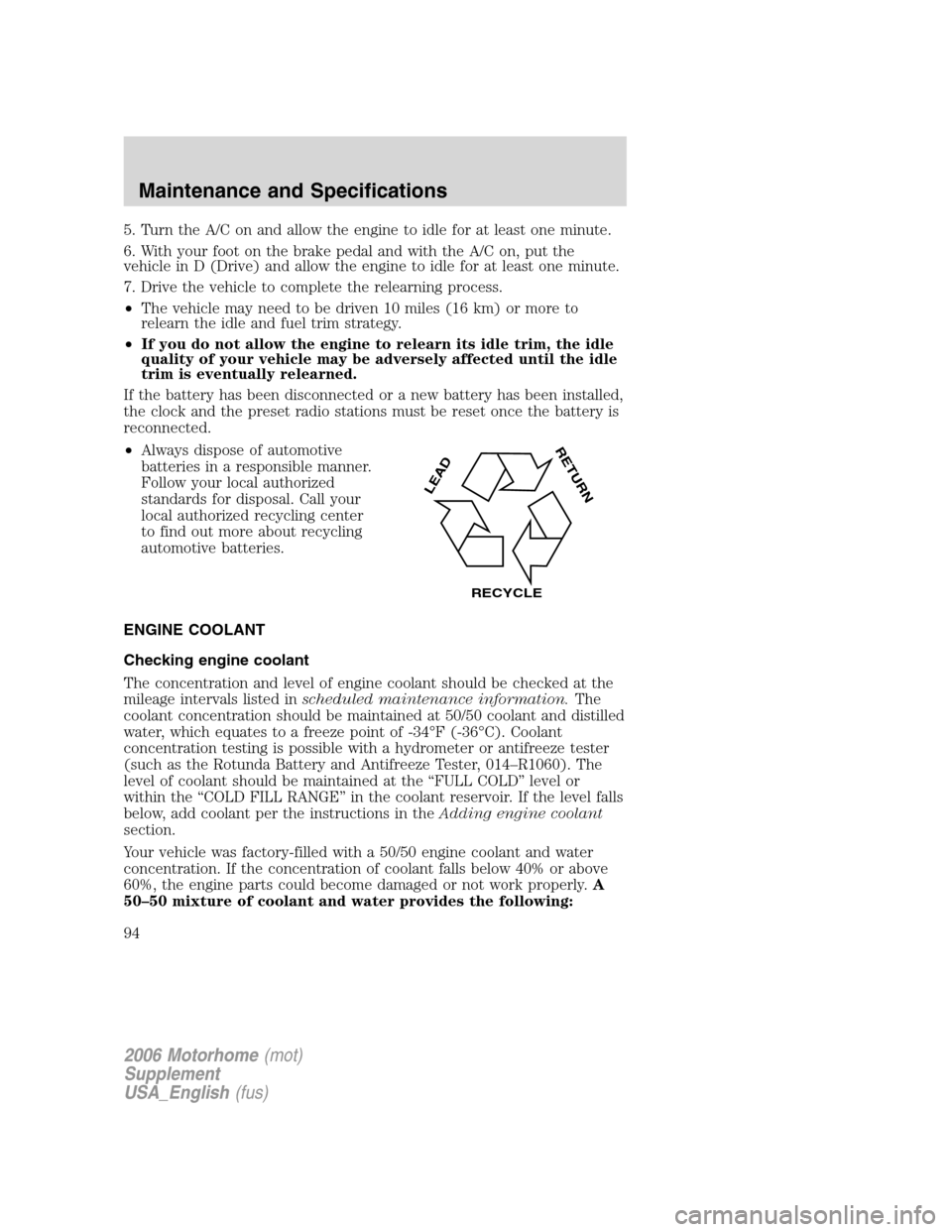
5. Turn the A/C on and allow the engine to idle for at least one minute.
6. With your foot on the brake pedal and with the A/C on, put the
vehicle in D (Drive) and allow the engine to idle for at least one minute.
7. Drive the vehicle to complete the relearning process.
•The vehicle may need to be driven 10 miles (16 km) or more to
relearn the idle and fuel trim strategy.
•If you do not allow the engine to relearn its idle trim, the idle
quality of your vehicle may be adversely affected until the idle
trim is eventually relearned.
If the battery has been disconnected or a new battery has been installed,
the clock and the preset radio stations must be reset once the battery is
reconnected.
•Always dispose of automotive
batteries in a responsible manner.
Follow your local authorized
standards for disposal. Call your
local authorized recycling center
to find out more about recycling
automotive batteries.
ENGINE COOLANT
Checking engine coolant
The concentration and level of engine coolant should be checked at the
mileage intervals listed inscheduled maintenance information.The
coolant concentration should be maintained at 50/50 coolant and distilled
water, which equates to a freeze point of -34°F (-36°C). Coolant
concentration testing is possible with a hydrometer or antifreeze tester
(such as the Rotunda Battery and Antifreeze Tester, 014–R1060). The
level of coolant should be maintained at the “FULL COLD” level or
within the “COLD FILL RANGE” in the coolant reservoir. If the level falls
below, add coolant per the instructions in theAdding engine coolant
section.
Your vehicle was factory-filled with a 50/50 engine coolant and water
concentration. If the concentration of coolant falls below 40% or above
60%, the engine parts could become damaged or not work properly.A
50–50 mixture of coolant and water provides the following:
L
E
A
D
RETURN
RECYCLE
2006 Motorhome(mot)
Supplement
USA_English(fus)
Maintenance and Specifications
94
Page 108 of 128
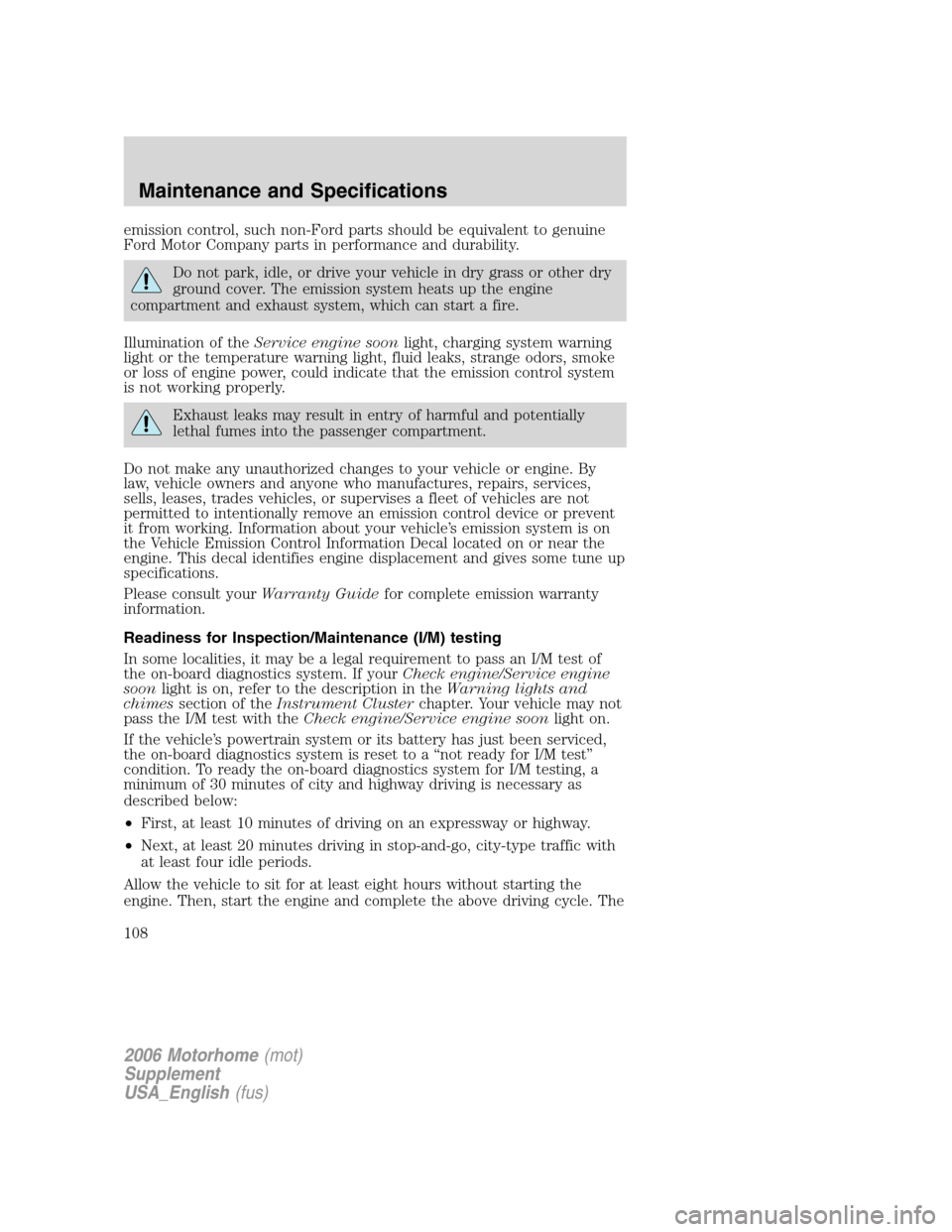
emission control, such non-Ford parts should be equivalent to genuine
Ford Motor Company parts in performance and durability.
Do not park, idle, or drive your vehicle in dry grass or other dry
ground cover. The emission system heats up the engine
compartment and exhaust system, which can start a fire.
Illumination of theService engine soonlight, charging system warning
light or the temperature warning light, fluid leaks, strange odors, smoke
or loss of engine power, could indicate that the emission control system
is not working properly.
Exhaust leaks may result in entry of harmful and potentially
lethal fumes into the passenger compartment.
Do not make any unauthorized changes to your vehicle or engine. By
law, vehicle owners and anyone who manufactures, repairs, services,
sells, leases, trades vehicles, or supervises a fleet of vehicles are not
permitted to intentionally remove an emission control device or prevent
it from working. Information about your vehicle’s emission system is on
the Vehicle Emission Control Information Decal located on or near the
engine. This decal identifies engine displacement and gives some tune up
specifications.
Please consult yourWarranty Guidefor complete emission warranty
information.
Readiness for Inspection/Maintenance (I/M) testing
In some localities, it may be a legal requirement to pass an I/M test of
the on-board diagnostics system. If yourCheck engine/Service engine
soonlight is on, refer to the description in theWarning lights and
chimessection of theInstrument Clusterchapter. Your vehicle may not
pass the I/M test with theCheck engine/Service engine soonlight on.
If the vehicle’s powertrain system or its battery has just been serviced,
the on-board diagnostics system is reset to a “not ready for I/M test”
condition. To ready the on-board diagnostics system for I/M testing, a
minimum of 30 minutes of city and highway driving is necessary as
described below:
•First, at least 10 minutes of driving on an expressway or highway.
•Next, at least 20 minutes driving in stop-and-go, city-type traffic with
at least four idle periods.
Allow the vehicle to sit for at least eight hours without starting the
engine. Then, start the engine and complete the above driving cycle. The
2006 Motorhome(mot)
Supplement
USA_English(fus)
Maintenance and Specifications
108
Page 116 of 128

Changing the air filter element
1. Loosen the latches that secure
the air filter cover in place.
2. Carefully separate the two halves
of the air filter housing.
3. Remove the air filter element
from the housing.
4. Install a new air filter element Be careful not to crimp the filter
element edges between the air filter housing. This could cause filter
damage and allow unmetered air to enter the engine if not properly
seated.
5. Replace the air filter cover to the housing and secure the latches.
MOTORCRAFT PART NUMBERS
Component 6.8L V10 engine
Air filter element FA-1782
Battery BXT-65-750
Fuel filter FG-872
Oil filter FL-820-S
PCV valve
1
Spark plugs2
Transmission remote filter FT-145
2006 Motorhome(mot)
Supplement
USA_English(fus)
Maintenance and Specifications
116
Page 123 of 128
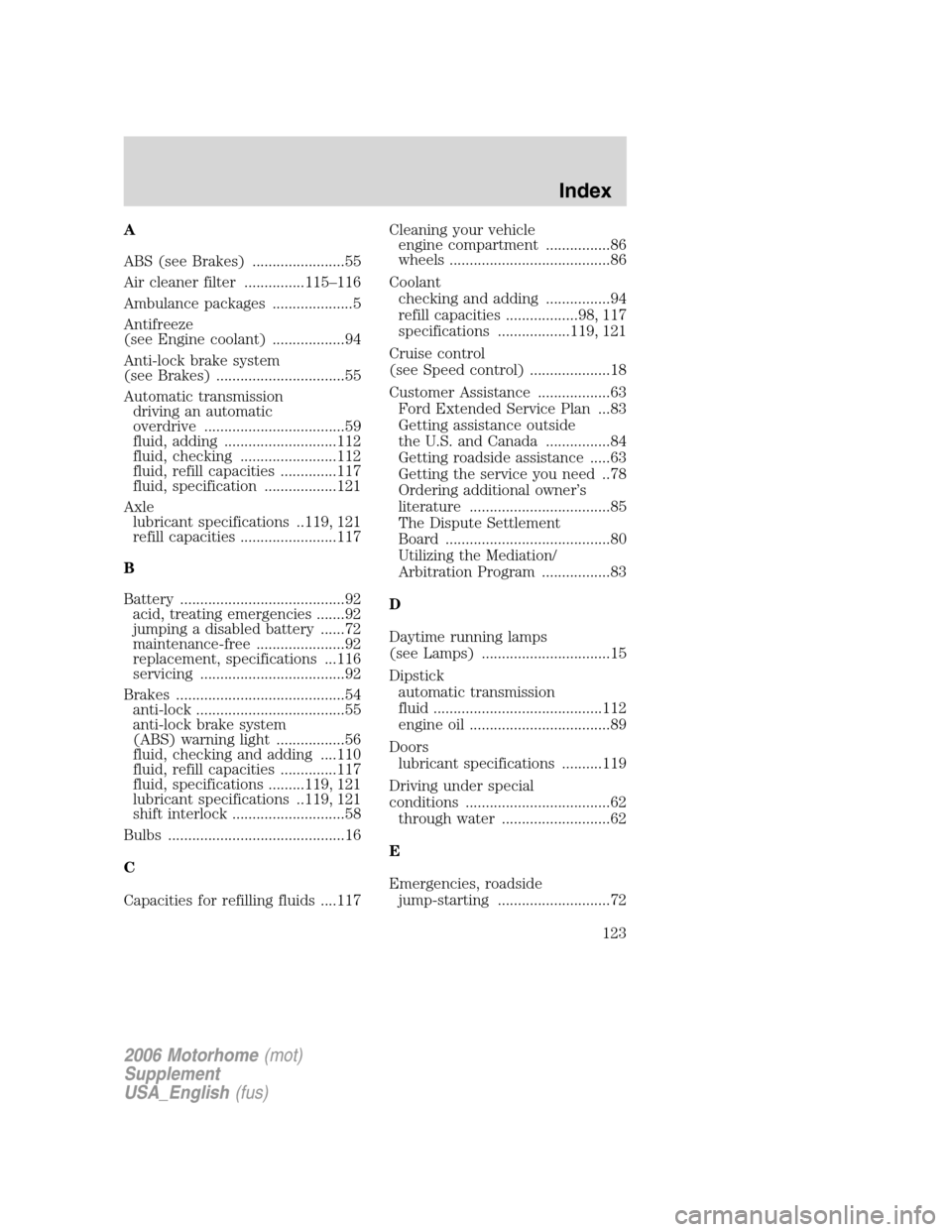
A
ABS (see Brakes) .......................55
Air cleaner filter ...............115–116
Ambulance packages ....................5
Antifreeze
(see Engine coolant) ..................94
Anti-lock brake system
(see Brakes) ................................55
Automatic transmission
driving an automatic
overdrive ...................................59
fluid, adding ............................112
fluid, checking ........................112
fluid, refill capacities ..............117
fluid, specification ..................121
Axle
lubricant specifications ..119, 121
refill capacities ........................117
B
Battery .........................................92
acid, treating emergencies .......92
jumping a disabled battery ......72
maintenance-free ......................92
replacement, specifications ...116
servicing ....................................92
Brakes ..........................................54
anti-lock .....................................55
anti-lock brake system
(ABS) warning light .................56
fluid, checking and adding ....110
fluid, refill capacities ..............117
fluid, specifications .........119, 121
lubricant specifications ..119, 121
shift interlock ............................58
Bulbs ............................................16
C
Capacities for refilling fluids ....117Cleaning your vehicle
engine compartment ................86
wheels ........................................86
Coolant
checking and adding ................94
refill capacities ..................98, 117
specifications ..................119, 121
Cruise control
(see Speed control) ....................18
Customer Assistance ..................63
Ford Extended Service Plan ...83
Getting assistance outside
the U.S. and Canada ................84
Getting roadside assistance .....63
Getting the service you need ..78
Ordering additional owner’s
literature ...................................85
The Dispute Settlement
Board .........................................80
Utilizing the Mediation/
Arbitration Program .................83
D
Daytime running lamps
(see Lamps) ................................15
Dipstick
automatic transmission
fluid ..........................................112
engine oil ...................................89
Doors
lubricant specifications ..........119
Driving under special
conditions ....................................62
through water ...........................62
E
Emergencies, roadside
jump-starting ............................72
2006 Motorhome(mot)
Supplement
USA_English(fus)
Index
123